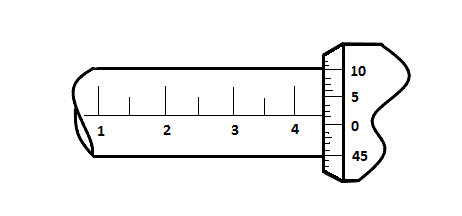
The diagram is a paper of micrometer screw gauge. What is the reading shown? Assume the pitch is $ 0.5mm $

A. $ 4.01mm $
B. $ 4.51mm $
C. $ 5.00mm $
D. None of these

Answer
486.3k+ views
Hint :In this question, we need to determine the reading of the micrometer screw gauge such that the pitch is 0.5 millimeters. First, we need to calculate the least count of the screw gauge. For this, we will recall the terms involved while measurements using a micrometer screw gauge.
Complete Step By Step Answer:
A micrometer screw gauge is used for measuring very small distances. It is used to measure small thickness of papers, wires and other minute items. A micrometer screw gauge has two scales – the linear scale and the circular scale.
The pitch of the screw gauge is calculated by dividing the distance moved by the linear scale in one turn of the circular scale by the number of divisions of the circular scale. In this question, the pitch is directly given to use.
Given,
The pitch of the micrometer screw gauge is $ 0.5mm $
Thus the least count of the screw gauge is given by
$
L.C = \dfrac{{pitch}}{\text{no.of circular divisions}} \\
= \dfrac{{0.5mm}}{{50}} \\
= 0.01mm \\
$
Now we see that the linear scale reading is $ 4.5mm $ and the circular scale has turned $ 1 $ divisions
Hence the final reading can be calculated by the formula
$ M = L.S.D + C.S.D \times L.C $
We put all the values here and then get the reading
$
M = 4.5mm + 1 \times 0.01mm \\
= 4.51mm \\
$
Hence option (B) is correct.
Note :
Vernier calipers may also be used to measure small distances. However a micrometer screw gauge can measure even smaller distances compared to the Vernier Calipers. Students should also know how to calculate the pitch of the micrometer screw gauge. Also the students should make sure there is no zero error. If any zero error is present it should be subtracted from the final reading.
Complete Step By Step Answer:
A micrometer screw gauge is used for measuring very small distances. It is used to measure small thickness of papers, wires and other minute items. A micrometer screw gauge has two scales – the linear scale and the circular scale.
The pitch of the screw gauge is calculated by dividing the distance moved by the linear scale in one turn of the circular scale by the number of divisions of the circular scale. In this question, the pitch is directly given to use.
Given,
The pitch of the micrometer screw gauge is $ 0.5mm $
Thus the least count of the screw gauge is given by
$
L.C = \dfrac{{pitch}}{\text{no.of circular divisions}} \\
= \dfrac{{0.5mm}}{{50}} \\
= 0.01mm \\
$
Now we see that the linear scale reading is $ 4.5mm $ and the circular scale has turned $ 1 $ divisions
Hence the final reading can be calculated by the formula
$ M = L.S.D + C.S.D \times L.C $
We put all the values here and then get the reading
$
M = 4.5mm + 1 \times 0.01mm \\
= 4.51mm \\
$
Hence option (B) is correct.
Note :
Vernier calipers may also be used to measure small distances. However a micrometer screw gauge can measure even smaller distances compared to the Vernier Calipers. Students should also know how to calculate the pitch of the micrometer screw gauge. Also the students should make sure there is no zero error. If any zero error is present it should be subtracted from the final reading.
Recently Updated Pages
Master Class 11 Business Studies: Engaging Questions & Answers for Success

Master Class 11 Computer Science: Engaging Questions & Answers for Success

Master Class 11 Maths: Engaging Questions & Answers for Success

Master Class 8 Science: Engaging Questions & Answers for Success

Master Class 10 Computer Science: Engaging Questions & Answers for Success

Master Class 10 Social Science: Engaging Questions & Answers for Success

Trending doubts
1 ton equals to A 100 kg B 1000 kg C 10 kg D 10000 class 11 physics CBSE

Difference Between Prokaryotic Cells and Eukaryotic Cells

One Metric ton is equal to kg A 10000 B 1000 C 100 class 11 physics CBSE

What is the opposite of entropy class 11 chemistry CBSE

Proton was discovered by A Thomson B Rutherford C Chadwick class 11 chemistry CBSE

Draw a diagram of nephron and explain its structur class 11 biology CBSE




